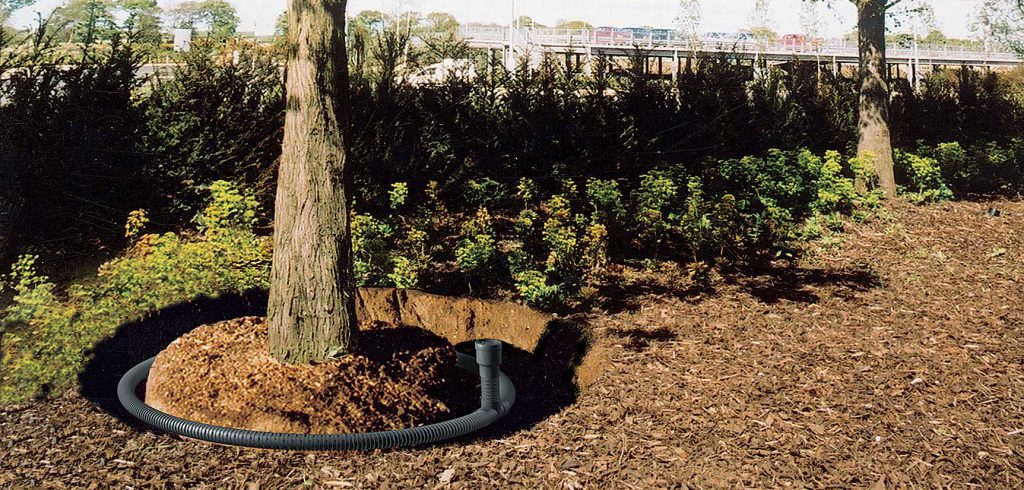Posted by Chester Gooden on Thu, Feb 17, 2022 @ 2:32 AM
How much Soil do Street Trees need?
This question often comes up, in workshops we hold about the urban forest. How much soil do street trees need? Striking the right balance ensures that street trees receive adequate nutrients, space for root growth, and proper water drainage. So what aspects about soil and the underground workings of trees do we have to consider?
Tree Root Systems are Extensive
The first thing to understand is that the root system of a tree is far more extensive than many people realize. In a natural environment, the root system extends as deep as possible in the soil profile, and typically very, very broadly in the upper layer of the soil profile. Wherever there is sufficient oxygen in the soil, and friability in the soil, to support the root growth of the tree – the roots will explore.

The root plate supports the canopy – but you can’t see it
The root system of the tree provides the structural support for the above-ground canopy, which is the part that we all see. That is a very, very critical function. A tree’s canopy can be very large, is extremely heavy, and is acted upon by the forces of nature – like wind, snow, rainfall etc. Within cities, the power of wind, (sometimes known as wind tunnel effect, or canyon effect), caused by proximity to tall buildings, causes ‘wind-throw’ forces in cities to be much greater than in a forest. So a tree’s root system is critical to anchor the tree physically, and also to support the healthy growth of the above-ground canopy.
A bigger tree requires a bigger soil volume
It’s important that we understand that the amount of soil required is relative to the mature canopy size of the chosen tree species. It’s not related to the size, pot, or box that the tree was grown in at the nursery. The quantity of soil volume that you provide for a tree in the street is all the soil that that tree is going to get – for its entire life. It’s important that the right amount is provided.
Soil Volume Calculator
Try our Treepit Costing Tool to find the level of soil a tree needs to support itself once it reach maturity level.

What is a tree coffin?
Historically, trees have been planted in small openings in pavements, sometimes called tree coffins. But this has resulted in catastrophic failure in pavements, and surrounding infrastructure, premature mortality for the tree, or consigning a tree to being stunted for its life if it does live. Walk the streets of any city in the world, and you will see this. So, it’s critical that the concept of soil volume is understood, if we truly wish to grow a healthy urban forest for future generations. The surprising fact is that with the correct volumes of good quality soil – the benefits can be enjoyed within your generation. The growth rates are astounding – we just need to get the basics right.

Why is the Treepit area really important?
Tree roots will grow a long way out from the trunk. Many people have had the experience of having an underground sewer or storm pipe penetrated by a tree’s root system, and the tree was growing a long way away, in a neighbor’s property. Trees will grow a long way out from the trunk – in many cases well beyond the canopy area.
What are ‘Deep Soil Zones’?
The other thing to be understood is the fact that depth of soil is also vital to accommodate the sheer size of the tree root system. For this reason, many cities are now mandating ‘deep soil zones’ for tree planting. This is critical, and is a very good move, to ensure that there is quality soil at a suitable depth, for the life needs of the urban forest As said before, tree root systems will grow as deep as there is adequate moisture, adequate aeration, (oxygen), as well as the essential elements of healthy soil.

At Citygreen we use Snorkil™ RootRain Urban to ensure oxygen and water can easily penetrate deeper into the soil zone which encourages the tree roots to grow deeper.

How to Calculate the Volume Required for Street Trees?
To arrive at a soil volume for a street tree, one simple rule of thumb is to start with the mature canopy size of the tree. Look up reliable tree resources, investigate online, or speak to the tree nursery, and establish what the mature canopy diameter of the tree species is going to be. Generally, this is very readily available. To what width will that tree grow at its full capacity? Then you turn the diameter into the area, by using the area formula. That gives you the area of the mature canopy (shade). Then you take that area, and multiply it by 0.6x a meter, or two feet in depth, to arrive at a target soil volume. Now, this is a rule of thumb, but it’s a very good place to start. There are other, more complicated formulas – but this is a good place to start.
Another tool we use regularly is the Soil Volume Simulator designed by Elke Haege-Thorvaldson. The soil volume simulator is a great tool designed to give you a rough estimate of minimum recommended soil volume taking in consideration around tree design and height, climate growing conditions, soil suitability, maintenance programs, and expected lifespan of the tree.
You can also review Elke’s recent talk at our event ‘Where the Shade Hits the Pavement‘ where she discusses soil design for landscapes and the soil volume needed.
Finding space for deep soil zones
Rarely is there room in a sidewalk, or a parking lot, or a paved area, for the entire deep soil zone to be an open garden bed. Due to pedestrian access demands, and vehicular movements – there is a requirement for extensive use of hard pavements. The good news is, there are ways of supporting the pavement while maintaining deep soil zones beneath that pavement. But establishing a correct soil volume for street trees is the first step in establishing a healthy and sustainable urban forest, and there are several ways of arriving at target costing based upon this.
To learn more about how to design and implement a successful urban forest project, engage with an expert here.


